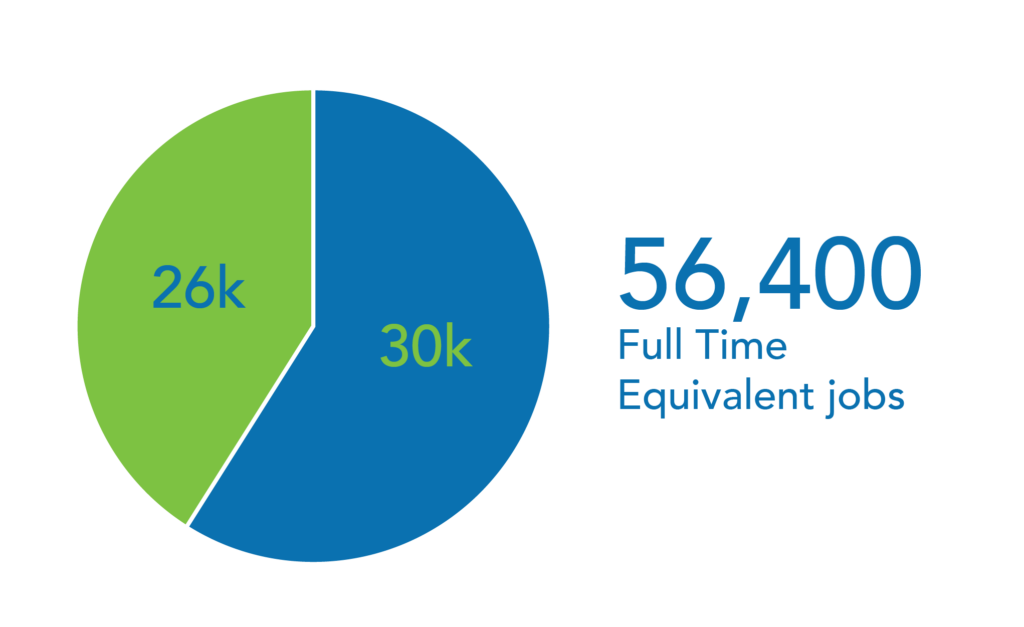
Collectively the twelve Yorkshire Universities member institutions…

Contribute nearly £3bn each year to the region’s economy and play a critical role in generating jobs, creating innovation, talent, and enterprise and driving productivity.
In 2017/18 £1.8bn was generated within the universities themselves, with the remainder in the supply chain and through expenditure of staff and students.
For example: the University of Bradford directly employs 1,260 FTE within the university and supports a total of 2,100 FTE (including supply chain, induced, student and visitor spend). In 2019, it bolstered the local economy of Bradford by more than £120 million through gross value added (GVA).
In Hull, the university supported 4,100 FTE jobs and contributed with £370 million GVA to the local economy.
In Leeds and Sheffield, the universities supported 16,930 FTE and 19,520 FTE jobs respectively and each contributed with £1 billion GVA to the local economy. In scale this local impact is most similar to that of Birmingham, Liverpool and Southampton.
Often the largest spillover effect comes from students, visitors and their expenditure, much of which flows to local retail, hospitality, culture and entertainment sectors and percolates throughout local economies.
Read more here about the local economic impact of universities here.

Invest £270 million in capital assets annually, helping to support local regeneration and capacity building in our region.
This includes residential, catering and other operational expenditure.
In many cases, universities drive major physical developments and regeneration schemes.

Universities in Yorkshire collectively spent around £250m in the region on suppliers out of a total of £590m spent in the UK.
Universities are, typically, large purchasers through their supply chains and some have been taking steps to buy locally where it makes sense.

Attract a large and diverse student population from more than 130 countries.
There are ten times more students studying from non-EU compared to EU countries. In 2021/22 the largest number of international students were by far from China, then India, Nigeria, Pakistan, Hong Kong (Special Administrative Region of China) and Kuwait.

Annually have over 220,000 students studying in Yorkshire, a third of whom were originally from within the region.
The majority of the students are studying full-time and for their first degree.
Overall there are more women enrolled in higher education than men.
The top most studied subject areas are: business and management, followed by subjects allied to medicine, then social sciences, then engineering and technology.

Develop highly-skilled people by producing over 74,870 graduates each year and creating opportunities for the region’s workforce.
In comparison, have a look at the graduate numbers in the rest of the regions:
| North East | 42,675 |
| North West | 88,445 |
| Yorkshire & Humber | 74,870 |
| West Midlands | 77,485 |
| East Midlands | 66,425 |
| East of England | 53,845 |
| London | 189,255 |
| South East | 106,960 |
| South West | 61,190 |
| Wales | 45,120 |
| Scotland | 93,775 |
| Northern Ireland | 19,900 |
| Total | 919,940 (compared to 774,730 in 2021/22) |

Support 56,400 Full Time Equivalent (FTE) jobs in the region. Over 30,000 of these FTEs are staff within the universities themselves, with a further 26,000 based in the wider supply chain, underpinned by the expenditure of staff and students.
On average, a full-time student spends around £11,000 per annum in term time, excluding tuition fees. As a very rough rule of thumb, every 1,000 full-time equivalent students typically support around 75 jobs off-campus locally, and more at the regional level.
Universities are often important local employers in their own right – in many cases, the largest after the NHS and local authority.
Among the twelve universities in Yorkshire there are more non-academic than academic staff working at the universities. The highest number of staff work in central administration and services, staff & student facilities. Followed by academic services, these include the following type of roles:
- administrative and secretarial occupations;
- associate professional and technical occupations;
- caring, leisure, and other service occupations;
- elementary occupations;
- managers, directors and senior officials;
- process, plant and machine operatives;
- professional occupations;
- sales and customer service occupations;
- skilled trades occupations.
These jobs are at a range of skill levels, but, on average, they are high quality and well paid. Average salaries are typically in excess of prevailing local averages.

Annually the 12 universities – generate over £32 million in consultancy contracts:
This constitutes over 3,500 contracts: over 1,200 are with non-commercial organisations, over 1,400 with SMEs and over 800 with other commercial businesses.
Generate nearly £129 million in contract research:
This constitutes over 3,000 contracts: 1,900 with non-commercial organisations, 300 with SMEs and nearly 900 with other commercial businesses.
Obtain over £165 million in collaborative research:
This includes public funding, in cash and in-kind collaboration contributions.

As anchor institutions, they are working together to support local councils, NHS and businesses and play a vital role in the region’s civic, social and cultural life through community outreach and volunteering, creating accessible and vibrant public places through libraries, arts and sporting facilities.
Prior to the pandemic there was a growing momentum behind the idea of universities being civic institutions working with local partners to drive local socio-economic development. Read more about the Civic University Network here and the Leeds Inclusive Anchor Network here.
Facing the challenges posed by the climate emergency and Covid-19, universities alongside further education have been playing a crucial role in formulating economic recovery plans, helping to reskill adults, supporting local businesses and start-ups, and in driving locally focussed research and innovation.
Read about the work universities have been doing in collaboration with the Yorkshire and Humber Climate Commission here.
Read about how universities contribute to the following areas:












